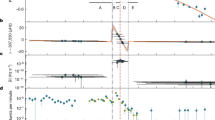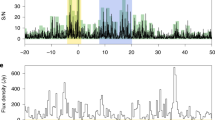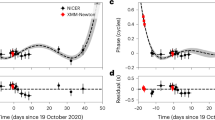Abstract
The radio-emitting neutron star population encompasses objects with spin periods ranging from milliseconds to tens of seconds. As they age and spin more slowly, their radio emission is expected to cease. We present the discovery of an ultra-long-period radio-emitting neutron star, PSR J0901-4046, with spin properties distinct from the known spin- and magnetic-decay-powered neutron stars. With a spin period of 75.88 s, a characteristic age of 5.3 Myr and a narrow pulse duty cycle, it is uncertain how its radio emission is generated and challenges our current understanding of how these systems evolve. The radio emission has unique spectro-temporal properties, such as quasi-periodicity and partial nulling, that provide important clues to the emission mechanism. Detecting similar sources is observationally challenging, which implies a larger undetected population. Our discovery establishes the existence of ultra-long-period neutron stars, suggesting a possible connection to the evolution of highly magnetized neutron stars, ultra-long-period magnetars and fast radio bursts.
This is a preview of subscription content, access via your institution
Access options
Access Nature and 54 other Nature Portfolio journals
Get Nature+, our best-value online-access subscription
$29.99 / 30 days
cancel any time
Subscribe to this journal
Receive 12 digital issues and online access to articles
$119.00 per year
only $9.92 per issue
Buy this article
- Purchase on Springer Link
- Instant access to full article PDF
Prices may be subject to local taxes which are calculated during checkout


Similar content being viewed by others
Data availability
The data that support the findings of this study are available at https://github.com/manishacaleb/MKT-J0901-4046.
Code availability
All code necessary for analyses of the data are available on GitHub (https://github.com/IanHeywood/oxkat) and Zenodo (https://doi.org/10.5281/zenodo.1212487).
References
Baring, M. G. & Harding, A. K. Radio-quiet pulsars with ultrastrong magnetic fields. Astrophys. J. Lett. 507, L55–L58 (1998).
Yao, J. M., Manchester, R. N. & Wang, N. A new electron-density model for estimation of pulsar and FRB distances. Astrophys. J. 835, 29 (2017).
Cordes, J. M. & Lazio, T. J. W. NE2001.I. A new model for the galactic distribution of free electrons and its fluctuations. Preprint at https://arxiv.org/abs/astro-ph/0207156 (2002).
The CHIME/FRB Collaboration et al. Sub-second periodicity in a fast radio burst. Preprint at https://arxiv.org/abs/2107.08463 (2021).
Levin, L. et al. Spin frequency evolution and pulse profile variations of the recently re-activated radio magnetar XTE J1810-197. Mon. Not. R. Astron. Soc. 488, 5251–5258 (2019).
Cordes, J. M. Pulsar microstructure: periodicities, polarization and probes of pulsar magnetospheres. Aust. J. Phys. 32, 9–24 (1979).
Kramer, M., Johnston, S. & van Straten, W. High-resolution single-pulse studies of the Vela pulsar. Mon. Not. R. Astron. Soc. 334, 523–532 (2002).
Wadiasingh, Z. & Chirenti, C. Fast radio burst trains from magnetar oscillations. Astrophys. J. Lett. 903, L38 (2020).
Lu, W., Kumar, P. & Zhang, B. A unified picture of Galactic and cosmological fast radio bursts. Mon. Not. R. Astron. Soc. 498, 1397–1405 (2020).
Beniamini, P., Wadiasingh, Z. & Metzger, B. D. Periodicity in recurrent fast radio bursts and the origin of ultralong period magnetars. Mon. Not. R. Astron. Soc. 496, 3390–3401 (2020).
Hurley-Walker, N. et al. A radio transient with unusually slow periodic emission. Nature 601, 526–530 (2022).
Yoneyama, T., Hayashida, K., Nakajima, H. & Matsumoto, H. Universal detection of high-temperature emission in X-ray isolated neutron stars. Publ. Astron. Soc. Jpn 71, 17 (2019).
Viganò, D. et al. Unifying the observational diversity of isolated neutron stars via magneto-thermal evolution models. Mon. Not. R. Astron. Soc. 434, 123–141 (2013).
Kramer, M., Stappers, B. W., Jessner, A., Lyne, A. G. & Jordan, C. A. Polarized radio emission from a magnetar. Mon. Not. R. Astron. Soc. 377, 107–119 (2007).
Dai, S. et al. Wideband polarized radio emission from the newly revived magnetar XTE J1810-197. Astrophys. J. Lett. 874, L14 (2019).
Becker, W. & Trümper, J. The X-ray luminosity of rotation-powered neutron stars. Astron. Astrophys. 326, 682–691 (1997).
Oppermann, N. et al. Estimating extragalactic Faraday rotation. Astron. Astrophys. 575, A118 (2015).
Johnston, S. & Karastergiou, A. The period–width relationship for radio pulsars revisited. Mon. Not. R. Astron. Soc. 485, 640–647 (2019).
Tan, C. M. et al. LOFAR discovery of a 23.5 s radio pulsar. Astrophys. J. 866, 54 (2018).
Morello, V. et al. The survey for pulsars and extragalactic radio bursts—IV. Discovery and polarimetry of a 12.1-s radio pulsar. Mon. Not. R. Astron. Soc. 493, 1165–1177 (2020).
Ruderman, M. A. & Sutherland, P. G. Theory of pulsars: polar gaps, sparks, and coherent microwave radiation. Astrophys. J. 196, 51–72 (1975).
Chen, K. & Ruderman, M. Pulsar death lines and death valley. Astrophys. J. 402, 264–270 (1993).
Tiengo, A. et al. A variable absorption feature in the X-ray spectrum of a magnetar. Nature 500, 312–314 (2013).
Riley, T. E. et al. A NICER view of PSR J0030+0451: millisecond pulsar parameter estimation. Astrophys. J. Lett. 887, L21 (2019).
Raaijmakers, G. et al. A NICER view of PSR J0030+0451: implications for the dense matter equation of state. Astrophys. J. Lett. 887, L22 (2019).
Kaspi, V. M. & Beloborodov, A. M. Magnetars. Annu. Rev. Astron. Astrophys. 55, 261–301 (2017).
Camilo, F. et al. Transient pulsed radio emission from a magnetar. Nature 442, 892–895 (2006).
Intema, H. T., Jagannathan, P., Mooley, K. P. & Frail, D. A. The GMRT 150 MHz all-sky radio survey. First alternative data release TGSS ADR1. Astron. Astrophys 598, A78 (2017).
Mauch, T. et al. SUMSS: a wide-field radio imaging survey of the southern sky—II. The source catalogue. Mon. Not. R. Astron. Soc. 342, 1117–1130 (2003).
McConnell, D. et al. The Rapid ASKAP Continuum Survey I: design and first results. Astron. Soc. Aust. 37, e048 (2020).
Manchester, R. N. et al. The Parkes multi-beam pulsar survey—I. observing and data analysis systems, discovery and timing of 100 pulsars. Mon. Not. R. Astron. Soc. 328, 17–35 (2001).
Marsh, T. R. et al. A radio-pulsing white dwarf binary star. Nature 537, 374–377 (2016).
Buckley, D. A. H., Meintjes, P. J., Potter, S. B., Marsh, T. R. & Gänsicke, B. T. Polarimetric evidence of a white dwarf pulsar in the binary system AR Scorpii. Nat. Astron. 1, 0029 (2017).
Gaibor, Y., Garnavich, P. M., Littlefield, C., Potter, S. B. & Buckley, D. A. H. An improved spin-down rate for the proposed white dwarf pulsar AR Scorpii. Mon. Not. R. Astron. Soc. 496, 4849–4856 (2020).
Keane, E. F. & Kramer, M. On the birthrates of Galactic neutron stars. Mon. Not. R. Astron. Soc. 391, 2009–2016 (2008).
McMullin, J. P., Waters, B., Schiebel, D., Young, W. & Golap, K. Shaw, R. A., Hill, F. & Bell, D. J. CASA architecture and applications. In Astronomical Data Analysis Software and Systems XVI (eds Shaw, R. A. et al.) 127–130 (Astronomical Society of the Pacific, 2007).
Offringa, A. R. et al. WSCLEAN: an implementation of a fast, generic wide-field imager for radio astronomy. Mon. Not. R. Astron. Soc. 444, 606–619 (2014).
Kenyon, J. S., Smirnov, O. M., Grobler, T. L. & Perkins, S. J. CUBICAL—fast radio interferometric calibration suite exploiting complex optimization. Mon. Not. R. Astron. Soc. 478, 2399–2415 (2018).
Heywood, I. oxkat: semi-automated imaging of MeerKAT observations. 2009.003 (Astrophysics Source Code Library, 2020).
Seymour, A., Michilli, D. & Pleunis, Z. DM_phase: algorithm for correcting dispersion of radio signals. 1910.004 (Astrophysics Source Code Library, 2019).
van Straten, W. & Bailes, M. DSPSR: digital signal processing software for pulsar astronomy. Astron. Soc. Aust. 28, 1–14 (2011).
Hotan, A. W., van Straten, W. & Manchester, R. N. PSRCHIVE and PSRFITS: an open approach to radio pulsar data storage and analysis. Astron. Soc. Aust. 21, 302–309 (2004).
Morello, V. et al. The high time resolution universe survey—XIV. Discovery of 23 pulsars through GPU-accelerated reprocessing. Mon. Not. R. Astron. Soc. 483, 3673–3685 (2019).
Hobbs, G. B., Edwards, R. T. & Manchester, R. N. TEMPO2, a new pulsar-timing package—I. An overview. Mon. Not. R. Astron. Soc. 369, 655–672 (2006).
Boriakoff, V. Pulsar AP 2016+28: high-frequency periodicity in the pulse microstructure. Astrophys. J. Lett. 208, L43–L46 (1976).
Lyne, A. & Graham-Smith, F. Pulsar Astronomy (Cambridge University Press, 2012).
Lange, C., Kramer, M., Wielebinski, R. & Jessner, A. Radio pulsar microstructure at 1.41 and 4.85 GHz. Astron. Astrophys 332, 111–120 (1998).
Cordes, J. M., Weisberg, J. M. & Hankins, T. H. Quasiperiodic microstructure in radio pulsar emission. Astron. J. 100, 1882–1891 (1990).
Mitra, D., Basu, R., Melikidze, G. I. & Arjunwadkar, M. A single spark model for PSR J2144-3933. Mon. Not. R. Astron. Soc. 492, 2468–2480 (2020).
Watts, A. L. et al. Colloquium: measuring the neutron star equation of state using X-ray timing. Rev. Mod. Phys. 88, 021001 (2016).
Evans, P. A. et al. GRB sample statistics from a uniform, automatic analysis of XRT data. In American Institute of Physics Conference Series Vol. 1133 (eds Meegan, C. et al.) 46–48 (American Institute of Physics, 2009).
Acknowledgements
This manuscript makes use of MeerKAT (Project ID: DDT-20210125-MC-01) and Parkes (Project ID: PX071) data. M.C. thanks South African Radio Astronomy Observatory (SARAO) for the approval of the MeerKAT DDT request and the science operations, Control and Monitoring/Central BeamFormer (CAM/CBF) and operator teams for their time and effort invested in the observations. The MeerKAT telescope is operated by the South African Radio Astronomy Observatory, which is a facility of the National Research Foundation, an agency of the Department of Science and Innovation. The Parkes Radio Telescope (Murriyang) is managed by CSIRO. We acknowledge the Wiradjuri people as the traditional owners of the Parkes observatory site. M.C. thanks the Australia Telescope National Facility (ATNF) for scheduling observations with the Parkes radio telescope. The SALT observations were obtained under the SALT Large Science Programme on transients (2018-2-LSP-001; PI: D.B.), which is also supported by Poland under grant no. MNiSW DIR/WK/2016/07. M.C., B.W.S., K.R., M.M., V.M., S.S., F.J., M.S., L.N.D and M.C.B. acknowledge funding from the European Research Council under the European Union’s Horizon 2020 research and innovation programme (grant agreement No 694745). M.C. acknowledges support of an Australian Research Council Discovery Early Career Research Award (project number DE220100819) funded by the Australian Government and the Australian Research Council Centre of Excellence for All Sky Astrophysics in 3 Dimensions, through project number CE170100013. K.R. acknowledges support from the Vici research programme ‘ARGO’ with project number 639.043.815, financed by the Dutch Research Council. J.v.d.E. is supported by a Lee Hysan Junior Research Fellowship awarded by St. Hilda’s College, Oxford. D.B. and P. Woudt acknowledge research support from the National Research Foundation.
Author information
Authors and Affiliations
Contributions
M.C. and B.W.S. drafted the manuscript with suggestions from co-authors. M.C. is the PI of the MeerKAT DDT and Parkes data. B.W.S. is the PI of the MeerTRAP data and R.F. and P.Woudt are the PIs of the ThunderKAT data. M.C. reduced and analysed the radio time domain data for quasi-periodicity and M.C. and M.K. interpreted it. I.H. calibrated, imaged and performed astrometry on the data to localize the source. B.W.S., V.M. and F.J. undertook the timing analyses. E.B. and K.R. designed and built the complex channelized data capture system. K.R. and P. Weltevrede performed the polarization analyses. M.M. carried out the pulse-width analyses using the wavelet transform method. E.B. and W.C. built and designed the beamformer used by MeerTRAP. J.v.d.E. and S.E.M. performed the Swift analysis. D.B., J.B. and P.Woudt obtained and analysed data from the SALT and South African Astronomical Observatory 1-m telescopes. F.J. and M.S. undertook analysis of the extant data. S.B. assisted in planning and scheduling the MeerKAT observations. S.S., F.J., M.S., R.F., L.N.D. and M.C.B contributed to discussions about the nature of the source.
Corresponding authors
Ethics declarations
Competing interests
The authors declare no competing interests.
Peer review
Peer review information
Nature Astronomy thanks the anonymous reviewers for their contribution to the peer review of this work.
Additional information
Publisher’s note Springer Nature remains neutral with regard to jurisdictional claims in published maps and institutional affiliations.
Extended data
Extended Data Fig. 1 Timing residuals of PSR J0901 − 4046.
The residuals from the best fit timing model given in Table 1. The orange data points are determined from the original MeerTRAP detection images, the first red diamond corresponds to a single pulse and the remaining red diamonds are determined from each of the half hour long follow-up observations with MeerKAT. The error bars are 1-σ. We used the L-band MeerKAT data for the timing analysis. The light coloured data points are from the Parkes UWL observations.
Extended Data Fig. 2 Examples of quasi-periodic pulses.
The top two rows show pulse profiles and their corresponding ACFs at 306.24μs resolution, respectively. The value the of quasi-period is indicated by the black vertical lines. The bottom two rows show the off-pulse regions and their corresponding ACFs.
Extended Data Fig. 3 Example of a pulse exhibiting more than one quasi-period.
Some quasi-periodic pulses as shown here, exhibit multiple quasi-periods within a single rotation.
Extended Data Fig. 4 Estimates of the quasi-period across all epochs.
The (orange) circles are the measured quasi-periods for each single pulse. The most commonly observed average quasi-period is 75.82 ms with the minimum period being 9.57 ms. The lags are arranged in lag length and not in time order.
Extended Data Fig. 5 Radio light-curves of PSR J0901 − 4046.
A regular series of pulsed emission detected in the L-band snapshot imaging for six observing epochs. Please refer to the Snapshot Imaging section of the Methods for details.
Extended Data Fig. 6 Polarization profiles of PSR J0901 − 4046 at 1.3 GHz and 700 MHz.
Top Panel: Time series of two single pulses of PSR J0901 − 4046 at 1284 MHz. Bottom Panel: Two different single pulse time series at 737 MHz. For both panels, the total intensity is represented by the black solid line, the red solid line denotes the linear polarization while the blue solid line denotes circular polarization. The polarization position angle is not absolutely calibrated at 737 MHz.
Extended Data Fig. 7 MeerKAT image of the PSR J0901 − 4046 region at 1.28 GHz.
The left hand panel shows the image with the pulsed emission included, and the right hand panel shows the same field following the removal of the integration times containing pulses. No persistent radio source is associated with PSR J0901 − 4046 to a 3σ limit of 18 μJy beam−1. The diffuse shell-like structure that surrounds PSR J0901 − 4046 is partially visible, possibly the supernova remnant from the event that formed the neutron star.
Supplementary information
Supplementary Information
Supplementary discussion and Figs. 1–9.
Rights and permissions
About this article
Cite this article
Caleb, M., Heywood, I., Rajwade, K. et al. Discovery of a radio-emitting neutron star with an ultra-long spin period of 76 s. Nat Astron 6, 828–836 (2022). https://doi.org/10.1038/s41550-022-01688-x
Received:
Accepted:
Published:
Issue Date:
DOI: https://doi.org/10.1038/s41550-022-01688-x
This article is cited by
-
Quasi-periodic sub-pulse structure as a unifying feature for radio-emitting neutron stars
Nature Astronomy (2023)
-
Enigma of GLEAM-X J162759.5–523504.3
Journal of Astrophysics and Astronomy (2023)
-
Searches for continuous-wave gravitational radiation
Living Reviews in Relativity (2023)
-
A 5.3-min-period pulsing white dwarf in a binary detected from radio to X-rays
Nature Astronomy (2023)
-
A long-period radio transient active for three decades
Nature (2023)



